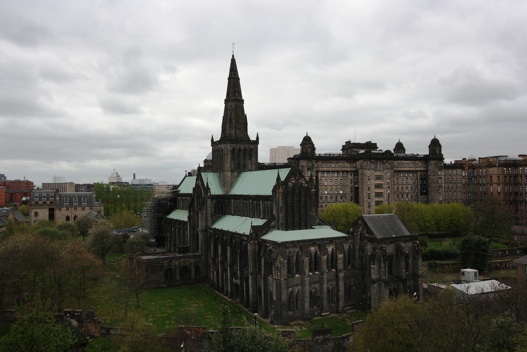
It was during the Roman occupation of South and Central Scotland that Christianity first made its presence felt, for it is related that when St Ninian passed through Cathures (early name for Glasgow) he consecrated a Christian cemetery there in the fourth century. St Kenitgern (Mungo) started a church on the banks of the Molendinar burn and was buried in its grounds when he died in 603. In the days of religious rule the importance of Glasgow in the south west of Scotland was assured by the presence of the cathedral.
The Cathedral was founded in 1136 and in 1456 Glasgow was made a Royal Burgh. In the Cathedral crypt lies the tomb of St Kenitgern (Mungo - the nickname given to him meaning “Dear One”) Patron Saint of Glasgow. Built in the 12th century the cathedral is one of Scotland's best preserved examples of Gothic architecture.
The Cathedral Windows - Munich Stained Glass
In 1856/57 the plan was conceived to put in stained glass windows. They were all to be made by the same firm to attain a unity of coloration and design, the firm commissioned for this task was The Royal Bavarian Stained Glass Est. (Königliche Glasmalereianstalt) near Munich, Germany. 10 Artists were set to work on the Glasgow Cathedral windows. They used a mosaic-enamel method, where the designs were created in stained glass and detail was added in enamel paint then fired to fuse with the glass. Between November 1859 and 1864 the stained glass windows were installed into the Cathedral. Unfortunately the stained glass windows were not to prove as permanent as was first hoped and within only a few years they showed signs of premature deterioration. The premature deterioration was put down to the effects of the industrial pollution in Glasgow at the time by some, while others believe that inferior workmanship on the part of the Munich artists was to blame.
By the 1930’s the condition of the windows was a serious concern and whilst some windows underwent repair there was a strong feeling that the German windows were not suitable or worthy of a Cathedral. Replacement of some of the windows commenced in 1934. Almost total removal and replacement of the Munich windows had been effected by 1960, just 100 years after their installation. Most were put into storage and three panels were selected to be conserved and exhibited as a representative of the body of work. Two original Munich glass windows remain in the Cathedral today. These are the Rose window above the door in the South Wall and some of the figures high up in the windows.
The original Munich glass windows made the Cathedral very dark as their strong coloration blocked a lot of light entering the Cathedral. The post war replacement windows contain only small panels of stained glass commemorating those who died in the two world wars.
Location: Castle street
Erected: 1197 (present cathedral)
See also:
Links:






